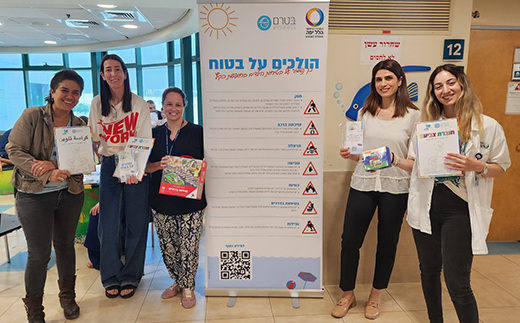In about a month, children will start summer vacation. During this time, the rate of injury to children at home and outside the home increases. To heighten awareness of the risks, the Department of Pediatrics held a summer safety week, during which they offered a wide variety of safety activities, both in the house and out, gave children coloring books, surprise gifts and games, along with information sheets about the existing risks and how to avoid them. The activity was organized by social worker Maram Kaawar of the Division of Pediatrics at Hillel Yaffe Medical Center, along with employees of the Educational Center and Beterm.
“There are different types of injuries, including burns, swallowing foreign objects, swallowing cleaning materials or medicines, drowning, traffic accidents (including electric bicycles), falls and fractures, choking, being forgotten in cars, cuts from sharp objects and more. The accident and the resulting hospital stay may lead to emotional, mental and physical implications both for the child and the parent. Unfortunately, at the hospital we see many accidents involving children. In some cases, I meet the parents, who on the one hand feel guilty, confused and responsible, and on the other hand are concerned and worried about their child's condition. The child experiences suffering and significant pain and sometimes even psychological trauma. Here we also provide a sympathetic ear, support and initial processing of the event, along with guidance and education, if necessary,” said Kaawar.

Division of Pediatrics and Beterm staff during Child Safety Week at Hillel Yaffe Medical Center
Accidents at home
Our homes are supposed to be our safe spaces, but accidents involving injuries to children actually occur frequently. For example, burns from a cup of boiling tea, swallowing cleaning products, inhaling foreign objects or choking. “Choking is the third most common cause of harm to children. Their airway is narrow compared to that of adults and, additionally, their cough reflex is not sufficiently developed and, therefore, they are unable to remove food or an object that was accidentally inhaled. When a small object or food is inhaled into the airway, it blocks the entry of air and can lead to choking and even a real life-threatening situation,” said Dr. Yitzhak Shochet, a physician in the ENT – Otolaryngology, Head & Neck Surgery Unit at Hillel Yaffe. “It is important to serve food that is suitable for the age of the toddler/child and to fully supervise them, particularly with young children and toddlers, and ensure that they aren’t putting foreign objects that they can inhale into their mouths.
More tips for preventing child injuries at home
-
Do not give children under the age of five nuts such as walnuts, peanuts and almonds, unless they are finely ground.
-
Make sure that your children stay away from a boiling electric kettle, hot drinks or anything hot that could burn them.
-
Make sure to keep medicines and cleaning products out of the reach of children so that they do not ingest them.
.jpg)
Hospitalized children participating in an activity for Safety Week
Accidents outside the home
Fun outside the home can pose various risks for injury to children. Crossing dangerous streets, riding a bicycle, being forgotten in the car, broken bones and falls. Terem shows that in 2023 there were 53 children and teens who died in traffic accidents, constituting 51% of all accidents - a 4% increase compared to 2019-2022. Another increase in the number of child and teen deaths was also seen due to drowning and injury/trauma.
“Injuries in bicycle accidents can range from mild cuts and bruises to more serious injuries such as broken bones, head trauma and spinal injuries. It is important to make sure they are dressed appropriately, wearing helmets and guards, follow the traffic laws and remain alert and aware of their surroundings. With respect to toddlers and children, make sure to buckle their seat belts, which can significantly reduce the severity of injury in case of a traffic accident,” said Hillel Yaffe’s Pediatric Division Director, Dr. Adi Klein.
“When you go out to enjoy a day at the beach or pool, you should only enter the water where there is a lifeguard and have a life preserver or water wings, depending on the age of the child, and do not to take your eyes off of them. In case of drowning, the length of time until help arrives is extremely critical. The harm that can occur is related to the amount of time from the moment of drowning to time of resuscitation/receipt of help.
In case of a sunburn, do not use disinfectants such as alcohol. It is advisable to apply soothing and cooling creams to the affected area. If the burns are more serious and blistering occurs, seek medical assistance.
In case jellyfish stings, remove the jellyfish's tentacles if they are stuck to the skin using a dry stick, and then rinse the area with tap water or clear sea water.
High temperatures can lead to dehydration and sunstroke, so it is important to drink lots of water throughout the day. Additionally, make sure to put on sunscreen and wear a hat. If your child gets dehydrated, give them fluids very frequently. If they do not cooperate and become apathetic, contact the doctor or the emergency room to receive IV fluids.
In short, the experts say that you need to be highly aware and adopt regular safety habits to minimize the number of injuries among children. Remember, a second of inattentiveness may lead to an irreversible tragedy.
Wishing you a safe summer!


.jpg)









.jpg?BannerID=39)

